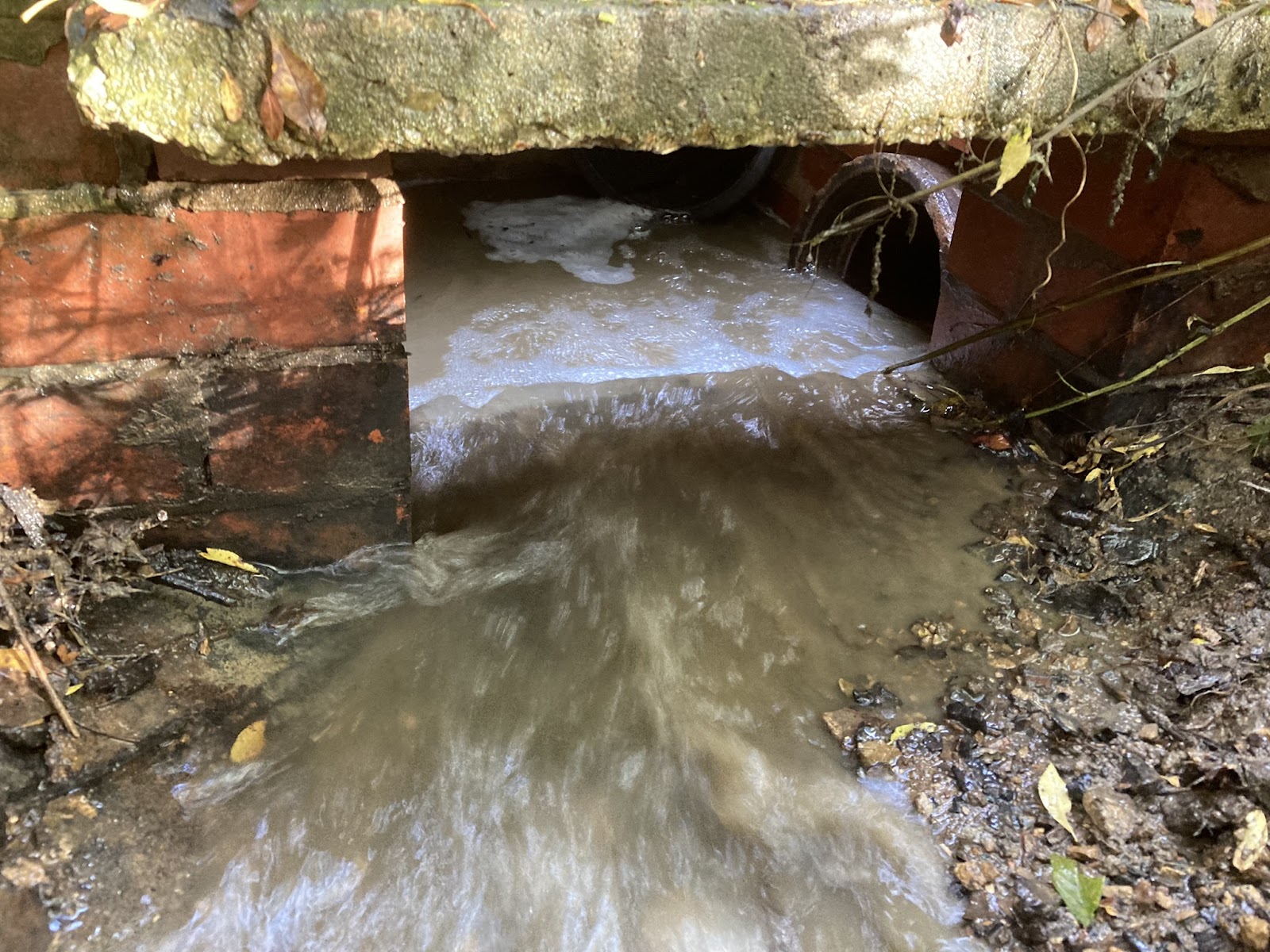Almost all the tasks that the Drainage team undertake come under the general description of maintenance. That is probably true for most of the other engineering departments on the GWSR, and on other heritage railways. Some of our infrastructure is over 120 years old, so it is not surprising we need to refurbish or rebuild some items from time to time. Whether a rebuild or a restoration is strictly maintenance is a debatable point. However, it is very rare for us to build something entirely new.
When I worked in the IT industry, we tried to make maintenance more glamorous. We coined the description that ‘maintenance was undertaking the development which had not happened in the development stage of a project’. It sort of worked!
Another common IT term is ‘preventative maintenance’. This covers the regular activities of fixing things before they broke.
Our recent activities have included examples of both types of maintenance. Regular clearing of silt at Laverton Meadow Lane is certainly preventative maintenance; whilst the work we completed at Stanton this year and that we have just started at Little Buckland are definitely categorised as improvements.
Thursday 3rd October
Eight of the team in attendance. This is now 80% of the team, as new team recruit Peter joined us. He will be dividing his time between track patrols with PWay and us.
With blue sky, lots of sunshine, almost no wind and by the afternoon warm temperatures, it was almost summer again! However the wet spell over the past two weeks meant some re-planning of the day's tasks. Main casualty was the leveling out of Gotherington yard - the ground was too wet and the clay too sticky for the telehandler. [Three weeks later the situation has not changed!]
We split into two teams — one of three and one of five.
Nigel, Dave and Martin took the 'new' white short wheel base
Transit van to Working Lane. Some difficulty was experienced
driving up the haul road to Royal Oak — the vehicle does not have
off-road rear tyres with a good grip. Once at the top they drove to
south of Gretton for the days clearing operations. First task was to
clear to the edge of the embankment to provide safe spaces to park a
vehicle the required 3m away from the running line. They then cleared
the inlets and outlets of cross drain 27A, culvert 27B and cross
drain 27C and the access all of these on both sides of the line. Next
was cross drain 28A at Stanley Pontlarge. This was mainly a silt
removal from the outlet chamber by the road in Keith Davies' field –
there was a lot of silt this year. Finally they cleared the long
steep zig-zag access to culvert 30A on the down side high mileage of
bridge 30; plus the inlet of the culvert. (Sorry no photographs, all three were too busy with the actual work!)
Meanwhile, Jonathan, Polly, Stuart, Peter and Andrew headed to Little Buckland. This was planned just as an inspection of the down (Cotswold) side of the section alongside Archer Farm, between Little Buckland (bridge 5) and the foot crossing near mile post 6 & three quarters. We had arranged to meet the owner of Archer Farm, he had noticed a large area of pooling water on one of his fields following the September heavy rain. An area of the field by the boundary fence just south of cross drain 5B was still under water. Immediately north of 5B the embankment toe ditch was flowing for a short distance, but became pools of standing water further along.
 |
| The flooded area in Archer Farm, south of cross drain 5B, two day before our first visit. [Photo from the farmer] |
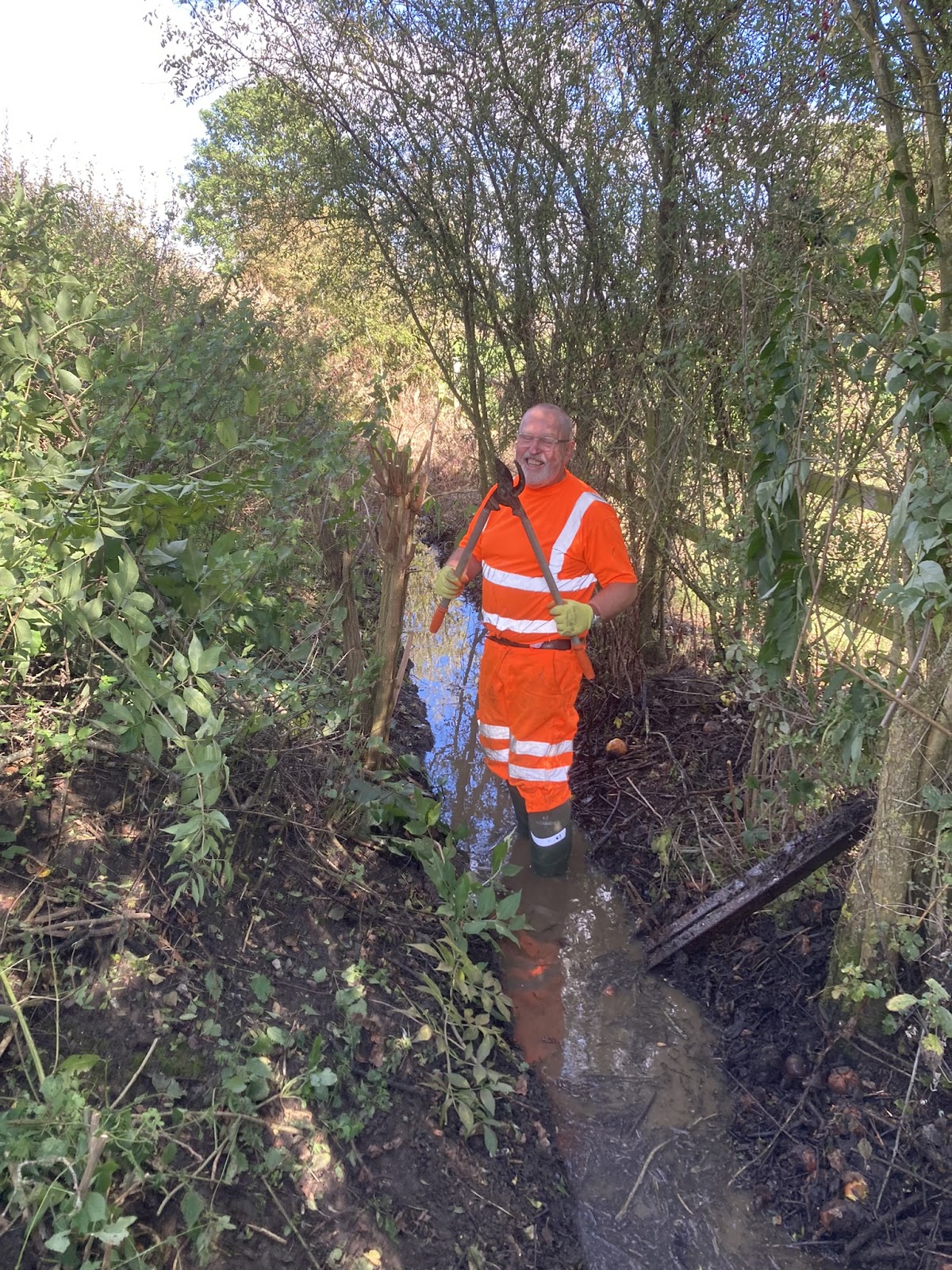 |
| Peter clearing the down side toe ditch north (low mileage) of 5B. Wellies essential. |
 |
| On the high mileage side (south) of 5b, Polly and Jonathan stand on the mound where the toe ditch should be. |
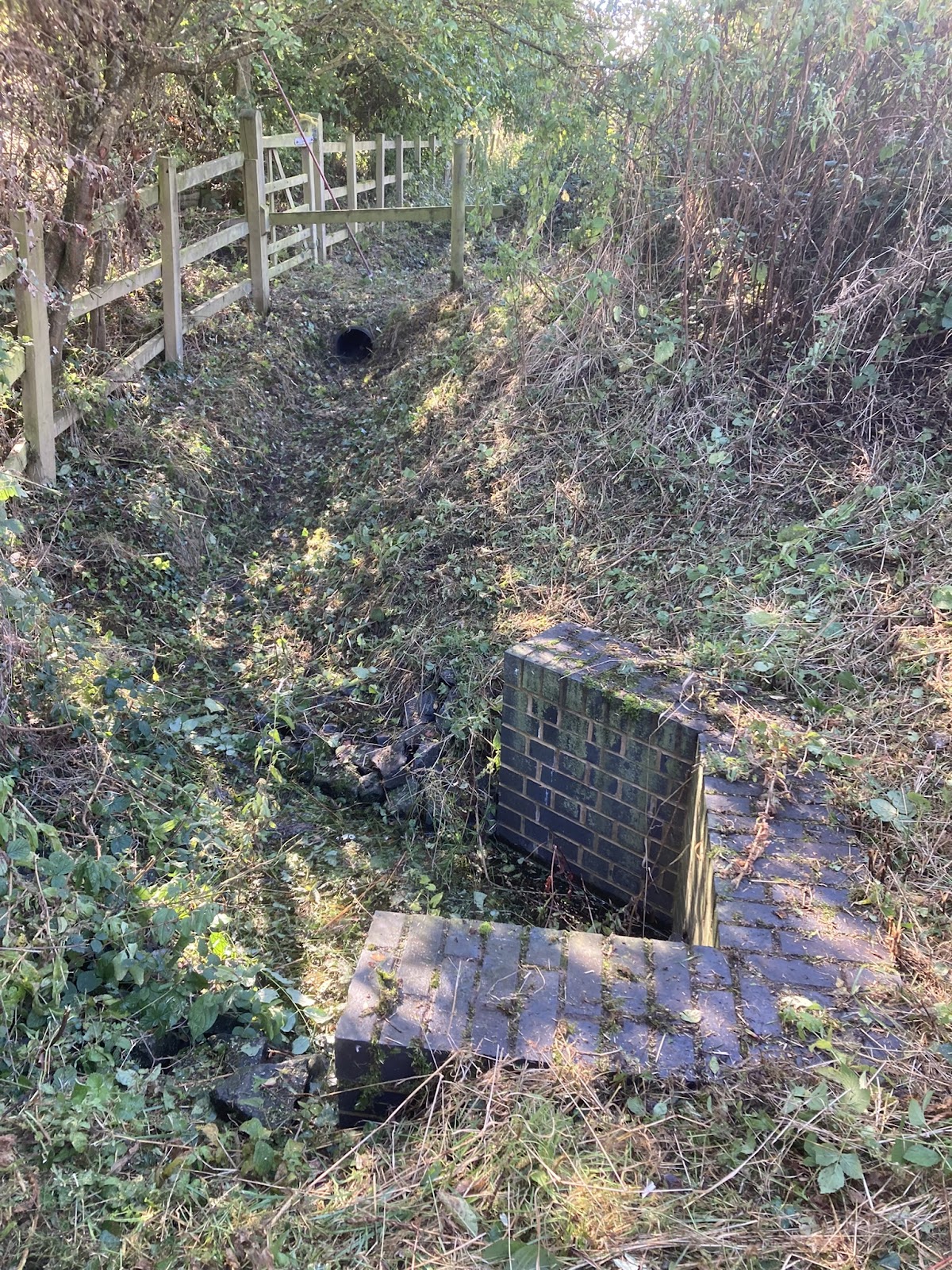 |
| 5A inlet and dry toe ditch - our aim is to clear the whole length like this. |
Wildlife report: The 'top' sighting was a stoat at Little Buckland. Actually two stoats as it was an adult (probably female) with a pup in her mouth. They quickly disappeared down the just cut access to down side 5A. Bigger mammals were spotted at Stanley Pontlarge — deer, probably muntjac but maybe roe. As usual they ran off before a positive identification was possible. On the flora side, we noticed many large fungi at Little Buckland.
Thursday 10th October
From a weather perspective, this was a day of improvement. Certainly from the precipitation point of view — but the effects of the past few wet weeks are still apparent. Both temperature and sunshine amounts vindicated the team member who insisted we took the deckchairs for lunchtime!
Dave, Nigel, Roger and Jonathan first attended to bridge 6,
Laverton Meadow. This was a spot of preventative maintenance,
clearing out the roadside gullies under the bridge to reduce
incidents of road flooding in the coming months. Surprisingly in view
of the heavy rain of recent weeks, the amount of silt in the gullies
was less than expected, but all was under water. Besides removing all
of the silt, the grills into the GCC drains were cleared of debris.
Hopefully this should suffice for a while - we plan to revisit before
Christmas.
 |
| Just running water under bridge 6; no silt, no floods, no stranded vehicles. [Photo by Dave] |
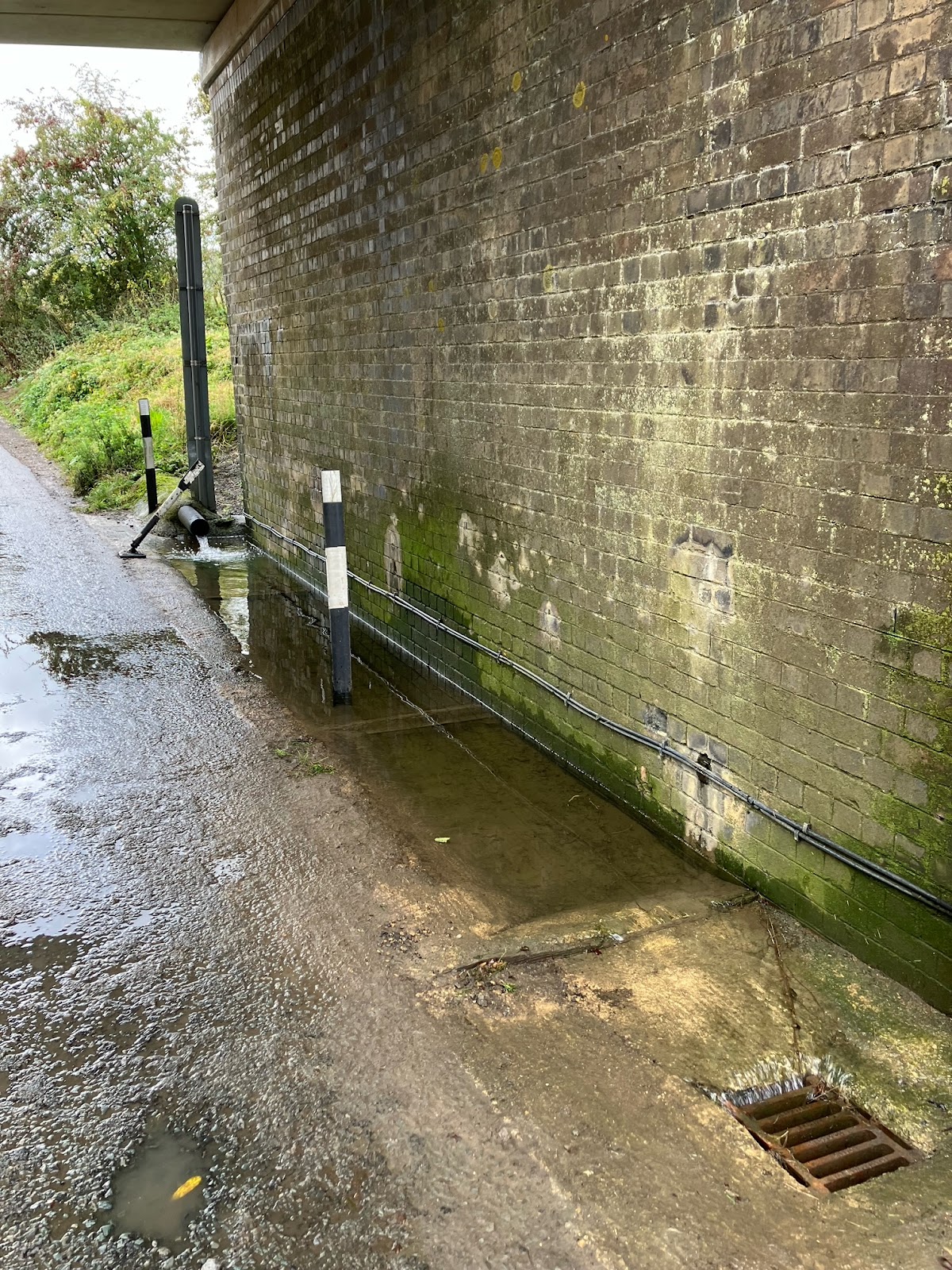 |
| Silt traps cleared. [Photo by Dave] |
Also we cleared the vegetation obscuring the road signs.
 |
| Before .... [Photo by Jonathan] |
 |
| ... and after the attention of the Roadside Clearance team. [Photo by Jonathan] |
Martin and Andrew went to Little Buckland bridge 5 - the first task being to improve the access to the trackside by removing the vegetation around the gate, and then to clear two safe vehicle parking spaces on the vacant trackbed (one by cross drain 5A and one by cross drain 5B). Then we completed the clearance of cross drain 5A and it's internal visual inspection.
 |
| 'Lake Archer' |
Then the full complement of attendees continued with the clearance of the down side toe ditch alongside Archer Farm. A contractor working for the farm’s owner had cleared along the fence line on the low mileage side of cross drain 5B - we removed fallen vegetation from that section. Also we cut another access down the embankment to that ditch. The contractor had made a start of removing the copse by the inlet of 5B; we continued with this as this is where we need to bring in our mini-digger for the excavation of the ditch. Unusually for the drainage team this, and some tree removal from the ditch, meant a chainsaw in use for most the day. On the high mileage side of 5B we made progress with the clearing of the toe of the embankment. This has revealed the full length where water is pooling. The flooded area in the field was larger and deeper than last week.
 |
| Initial clearing of the ditch and fence line on the low mileage side of 5B has already made a big difference. |
Finally we rodded the inlet to cross drain 5B from the farm's pond, this dislodged some silt and improved the flow. We marked the distance where our rods were encountering an obstruction. We anticipate quite a few more days work here, probably with the mini-digger starting ditch excavation in November. The farm owner is being extremely cooperative — we have been granted access through the farm and can put cut vegetation on heaps in his fields. He will certainly have some large bonfires this winter!
 |
| Jonathan feeding drain rods into the inlet chamber of 5B. |
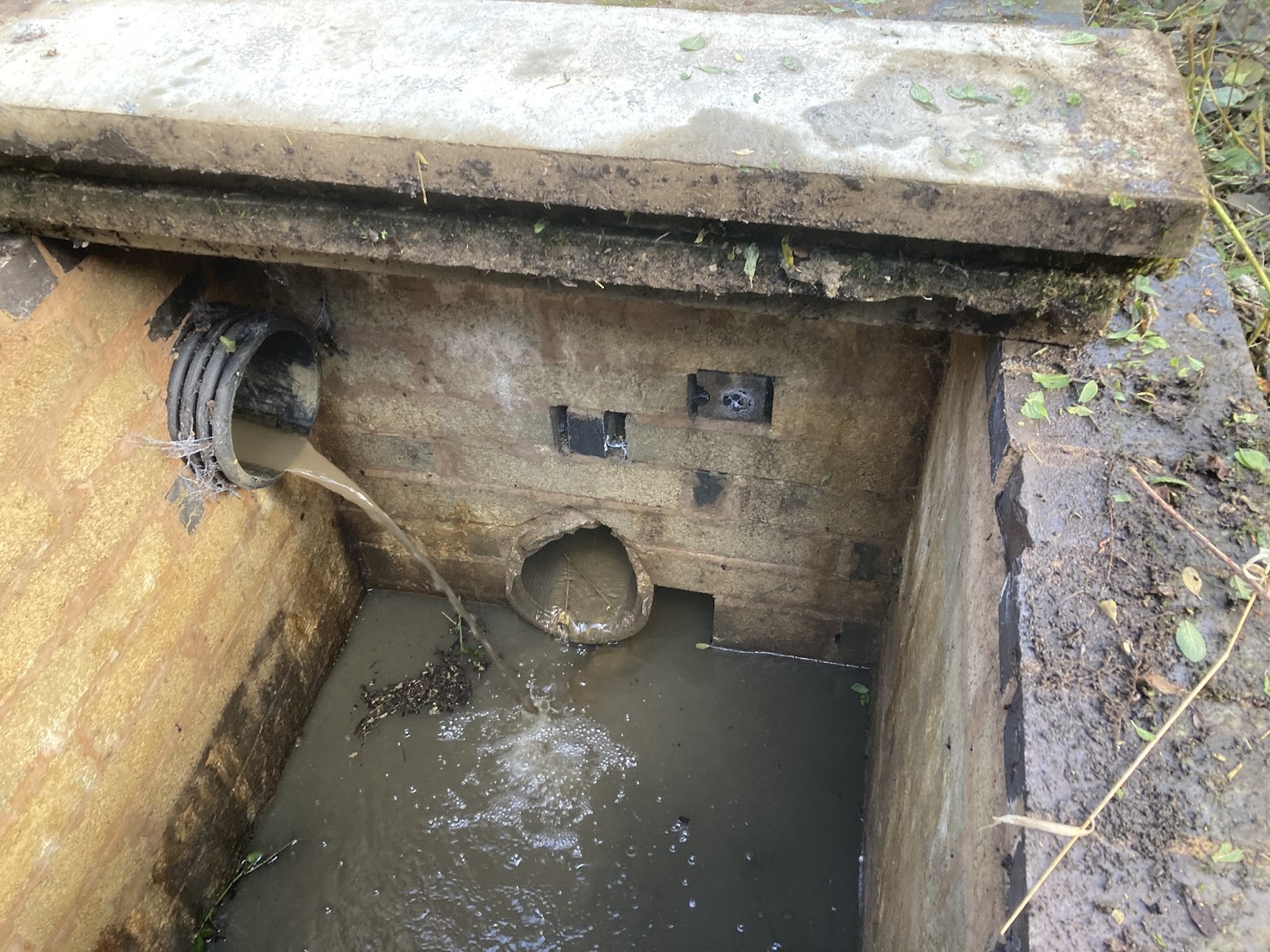 | |
| A small flow detected from the pond overflow into the inlet of 5B (lower pipe); the bigger flow from the pipe on the left is from the low mileage toe ditch. |
Wildlife report: At lunchtime we had a close encounter with a curious pheasant the other side of the four foot at Little Buckland; later we noticed a raptor in a tree eyeing up the pheasant. Plenty of mushrooms/toadstools in the damp areas of the embankment and adjoining field.
Thursday 17th October
Only half the team (5) in attendance — consequently a reduced number of tasks from the 'to do' list ticked off.
Jonathan and Andrew headed south to Stanley Pontlarge. They undertook the visual inspections of cross drains 28A, 27C and 27A, and culvert 27B. At 27A they spoke with the ground works team working on the new housing development on the up side next to the White Cottage. Six houses are being built here (you could say squeezed in, they will not have very large gardens!). Next on the list was the inspection of cross drain 25B, but this was postponed as the the water level was still too high. Some dredging of the outlet ditch in the adjoining field is required here.
 |
| This is the same flow (plus a bit more) entering the inlet chamber of culvert 27B by Townsend Farm. |
Next it was installation of the new 'Do not trespass' signs on the down side alongside the Royal Oak pub at Gretton. One is close to the boundary fence by culvert 24A, low mileage of the pub garden; and the other is between the cess and the hedge by the high mileage end of the pub garden.
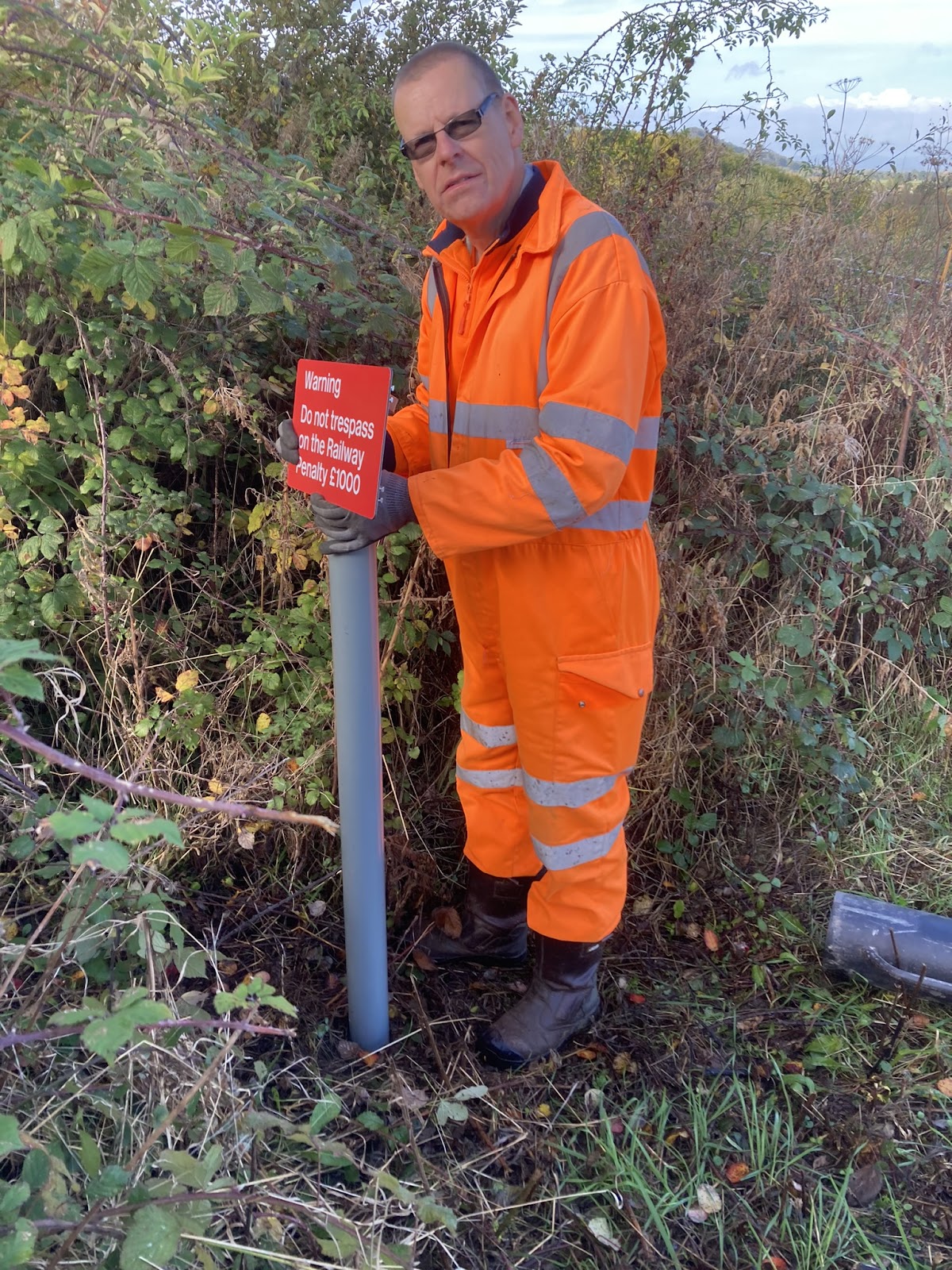 | |
| Jonathan attaches one of the new Trespass warning signs by the Royal Oak. One advantage of a wet spell is that the ground is soft, so hammering in the post was not difficult! |
Then a look at the down side boundary fence on the tunnel cutting
at the point where the pub's shepherd hut field joins the adjacent
field. Trespassers (probably train photographers) have damaged the
fence here, removing several lengths of barbed wire. The two-man team
made temporary repairs with what they had to hand; it needs a proper
repair and another 'Do not trespass' sign installed. [Both
scheduled for our fencing contractor to attend to later this autumn].
After lunch, the top of the haul road has arguably the best view on
the railway, the two joined the other three team members at Little
Buckland.
 |
| Yes a very good spot for photographing trains - but please keep to the field side of the fence. |
Roger, Dave and Polly headed for Little Buckland first thing.
Their initial job was to clear the old field gate just south of
bridge 4 — this to enable vehicles to turn safely. However due to
the restricted width and the wet grass, we only recommend turning
4-wheel drive vehicles there (so NOT the Transits).
 |
| Soon to be a historic picture, the three car class 117 DMU passing the cleared old field entrance just south of Peasbrook Farm. |
Then it was vegetation clearance of cross drain 3A and culvert 3B. Two more where the wet summer has had its effect — outlet of 3B on the down side was too dangerous to cut (wet and steep); whilst the inlet of 3A took a considerable time to clear as it was full of timber detritus from a nearby willow tree.
 |
| The inlet of cross drain 3A before clearance - full of bits of willow tree. [Photo by Roger] |
 |
| What a difference - yes this is the same spot a few hours later. |
After lunch, the full complement of five undertook clearing of culvert 4A and visual inspections of 3A (part), 3B and 4A. Also at cross drain 5B Jonathan and Polly attempted further rodding of the inlet from the pond overflow in Archer Farm. Whilst the small flexible disc on the drain rods seemed to get past the obstruction; anything bigger didn't. So we suspect the obstruction is clay in the bottom of the pipe; or a badly aligned pipe join. This information we have passed on to the farm owner, he plans to call in a contractor to renew this pipe. The team then cleared some more obstructions from the embankment toe ditch alongside Archer Farm on the low mileage side of 5B.
Finally back at Winchcombe we undertook yet another form of maintenance — that of our power tools. Specifically this was to some of the brush cutters, some have a reversible blade which need periodic turning over to even the wear on the cutting edges.
 |
| End of day cuppa tea time at Winchcombe coincides with the last steam train to Cheltenham. War time GW black does suit 3850. |
Wildlife report: Two roe deer, one rabbit, pheasants by the score, a kestrel and damsel fly all spotted between Laverton and Peasbrook Farm.
